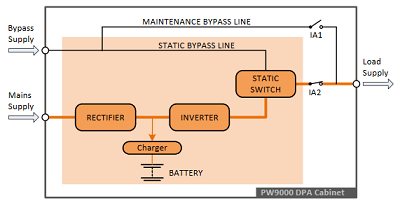Nowadays specifying, purchasing and installing a UPS system should be a trouble-free experience, provided you deal with a knowledgeable and reputable UPS supplier. However as every user organisation has its own mix of circumstances, challenges and priorities, choosing the UPS solution that’s best for you isn’t always straightforward. Take advantage of our major pitfalls list below to remove this uncertainty from your UPS buying process.
- Be aware of the true load presented to the UPS system. How much of your organisation’s equipment is in use at any one time? Are you allowing for the effects of power factor, problem loads such as fluorescent lights that draw high or pulsed current, or motors that draw heavy start-up current?
- Are you caring for your UPS batteries sufficiently? Well-designed UPSs will protect batteries from harm due to overcharging, undercharging, or charging inappropriate to ambient temperature. Ambient temperature must be carefully controlled to prevent it compromising battery life and performance.
- Running costs – Your UPS system is a major equipment item, so make sure it’s a high efficiency UPS design with low input current harmonic distortion, avoiding excessive energy and cooling bills, and preserving your Green image.
- Avoid system crashes – do you have sufficient UPS battery autonomy to guarantee a graceful shutdown of your IT system during an extended power outage?
- Managing changing load – Is your UPS’s load expected to grow? If so, how easy is it to scale up your UPS design accordingly, without interrupting power to the load or needing more floorspace?
- Environmental considerations – Maintaining the UPS supplier’s recommended ambient temperature is essential for preserving battery life. Similarly, you must comply with humidity guidelines to prevent possible corrosion of cabinets and internal parts. Also, check that the audible noise in dBA emitted by the UPS under its expected load is acceptable for its target location.
- If you want to complement your UPS with a generator for extended power blackout cover, check that the stand by generator has UPS compatibility designed in. It must be right-sized, amenable to start and stop signals, and retain voltage and frequency stability even with rapidly-changing loads.
- Delivery to site – Large UPS systems, especially with batteries, are heavy and unwieldy while also containing delicate electronic equipment. Expert contractors with specialised transportation and lifting equipment are needed to deliver, unload and position the UPS system. Ask your UPS supplier to recommend handling procedures and suitably experienced transportation contractors.
- Planning for UPS maintenance – Are you specifying a modular UPS system with hot swappable power supply that can be exchanged without interruption to power? Is there sufficient access for engineers to perform maintenance or UPS systems? Has the system an external maintenance bypass facility?
- To avoid these pitfalls and other issues you may not be aware of, consult a reputable, experienced UPS supplier and obtain their professional advice. They will be your partner for the next 10 -15 years.
Contact KUP for all your UPS, generator and maintenance requirements: 0800 731 3269 or email us at [email protected] .
Follow us on LinkedIn for regular industry articles & company information




